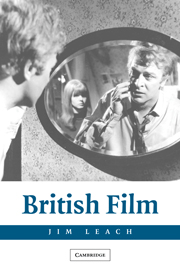Book contents
- Frontmatter
- Contents
- Acknowledgments
- Introduction
- 1 The National Health: Great Britain/Deep England
- 2 The Magic Box: What Is British Cinema?
- 3 The Common Touch: The Art of Being Realistic
- 4 The Mirror Crack'd: British Expressionism
- 5 Millions like Us: National Cinema as Popular Cinema
- 6 The Stars Look Down: Acting British
- 7 No Sex Please – We're British: Sex, Gender, and the National Character
- 8 Carry On Regardless: The British Sense of Humor
- 9 Sexy Beasts: British Monsters
- 10 The Ruling Class: Ideology and the School Movie
- 11 The Long Memory: History and Heritage
- 12 I'm British but … : Empire and After
- Notes
- Bibliography
- Filmography
- Index
6 - The Stars Look Down: Acting British
Published online by Cambridge University Press: 07 May 2010
- Frontmatter
- Contents
- Acknowledgments
- Introduction
- 1 The National Health: Great Britain/Deep England
- 2 The Magic Box: What Is British Cinema?
- 3 The Common Touch: The Art of Being Realistic
- 4 The Mirror Crack'd: British Expressionism
- 5 Millions like Us: National Cinema as Popular Cinema
- 6 The Stars Look Down: Acting British
- 7 No Sex Please – We're British: Sex, Gender, and the National Character
- 8 Carry On Regardless: The British Sense of Humor
- 9 Sexy Beasts: British Monsters
- 10 The Ruling Class: Ideology and the School Movie
- 11 The Long Memory: History and Heritage
- 12 I'm British but … : Empire and After
- Notes
- Bibliography
- Filmography
- Index
Summary
Critics often refer to the close relations between the theater and the British film industry as a negative factor that has discouraged filmmakers from developing the full possibilities of their medium. When the major film studios developed in the 1920s, they were located in and around London, within easy reach of the West End, as opposed to the large distance that separated Hollywood from the New York theaters. It is true that this circumstance made it easy for British film producers to recruit stage actors who could return for evening performances after a day of filming. It is also true that some productions seemed artificial and stagebound, especially in the years immediately following the introduction of sound. Yet many actors, playwrights, and directors have moved back and forth between stage and screen with uneven, but often effective, results. In any case, the theatrical influence came not just from the “legitimate” stage but from more “popular” forms, especially music hall and variety.
Although the influence of the realist tradition encouraged the idea that film acting should be more restrained, and thus more “natural,” than theatrical performance, acting in the form of role-playing is very much part of everyday life and is often associated with national stereotypes. Similarly, although dramatic conventions and structures may seem ill suited to the more fluid sense of space and time of the film medium, they can be used to convey a sense of the social conventions and scenarios that frame our lives.
- Type
- Chapter
- Information
- British Film , pp. 104 - 123Publisher: Cambridge University PressPrint publication year: 2004

